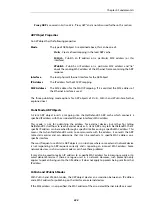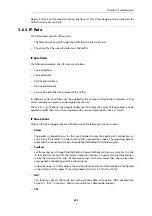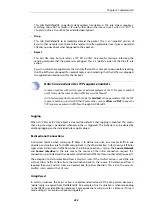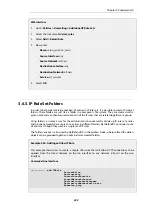
This behavior can be changed by modifying the advanced setting Unsolicited ARP Replies.
ARP Requests
The ARP specification states that a host should update its ARP Cache with data from ARP
requests received from other hosts. However, as this procedure can facilitate hijacking of local
connections, NetDefendOS will normally not allow this.
To make the behavior compliant with the RFC 826 specification, the administrator can modify
the setting ARP Requests. Even if this is set to
Drop
(meaning that the packet is discarded
without being stored), NetDefendOS will reply to it provided that other rules approve the
request.
Changes to the ARP Cache
A received ARP reply or ARP request can possibly alter an existing entry in the ARP cache.
Allowing this to take place may allow hijacking of local connections. However, not allowing this
may cause problems if, for example, a network adapter is replaced since NetDefendOS will not
accept the new address until the previous ARP cache entry has timed out.
The advanced setting Static ARP Changes can modify this behavior. The default behavior is that
NetDefendOS will allow changes to take place, but all such changes will be logged.
A similar issue occurs when information in ARP replies or ARP requests could collide with static
entries in the ARP cache. This should not be allowed to happen and changing the setting Static
ARP Changes allows the administrator to specify whether or not such situations are logged.
Sender IP 0.0.0.0
NetDefendOS can be configured for handling ARP queries that have a sender IP of
0.0.0.0
. Such
sender IPs are never valid as responses, but network units that have not yet learned of their IP
address sometimes ask ARP questions with an "unspecified" sender IP. Normally, these ARP
replies are dropped and logged, but the behavior can be changed by modifying the setting ARP
Query No Sender.
Matching Ethernet Addresses
By default, NetDefendOS will require that the sender address at Ethernet level should comply
with the Ethernet address reported in the ARP data. If this is not the case, the reply will be
dropped and logged. The behavior can be changed by modifying the setting ARP Match
Ethernet Sender.
Chapter 3: Fundamentals
227
Содержание NetDefendOS
Страница 30: ...Figure 1 3 Packet Flow Schematic Part III Chapter 1 NetDefendOS Overview 30 ...
Страница 32: ...Chapter 1 NetDefendOS Overview 32 ...
Страница 144: ...Chapter 2 Management and Maintenance 144 ...
Страница 220: ... Enable DHCP passthrough Enable L2 passthrough for non IP protocols 4 Click OK Chapter 3 Fundamentals 220 ...
Страница 267: ... SourceNetwork lannet DestinationInterface any DestinationNetwork all nets 4 Click OK Chapter 3 Fundamentals 267 ...
Страница 284: ...Chapter 3 Fundamentals 284 ...
Страница 360: ...The ospf command options are fully described in the separate NetDefendOS CLI Reference Guide Chapter 4 Routing 360 ...
Страница 392: ...Chapter 4 Routing 392 ...
Страница 396: ...Web Interface 1 Go to Network Ethernet If1 2 Select Enable DHCP 3 Click OK Chapter 5 DHCP Services 396 ...
Страница 419: ... Host 2001 DB8 1 MAC 00 90 12 13 14 15 5 Click OK Chapter 5 DHCP Services 419 ...
Страница 420: ...Chapter 5 DHCP Services 420 ...
Страница 424: ...2 Now enter Name lan_Access Action Expect Interface lan Network lannet 3 Click OK Chapter 6 Security Mechanisms 424 ...
Страница 573: ...Chapter 6 Security Mechanisms 573 ...
Страница 575: ...This section describes and provides examples of configuring NAT and SAT rules Chapter 7 Address Translation 575 ...
Страница 607: ...Chapter 7 Address Translation 607 ...
Страница 666: ...Chapter 8 User Authentication 666 ...
Страница 775: ...Chapter 9 VPN 775 ...
Страница 819: ...Chapter 10 Traffic Management 819 ...
Страница 842: ...Chapter 11 High Availability 842 ...
Страница 866: ...Default Enabled Chapter 13 Advanced Settings 866 ...
Страница 879: ...Chapter 13 Advanced Settings 879 ...
















































